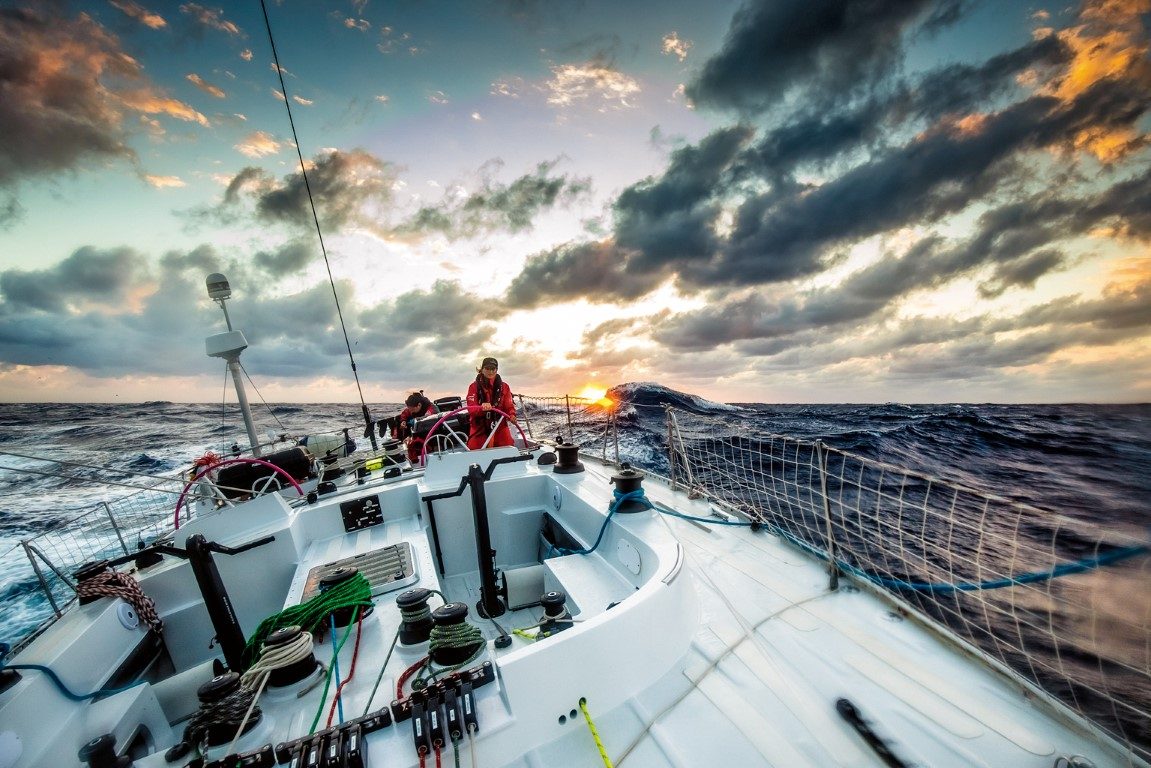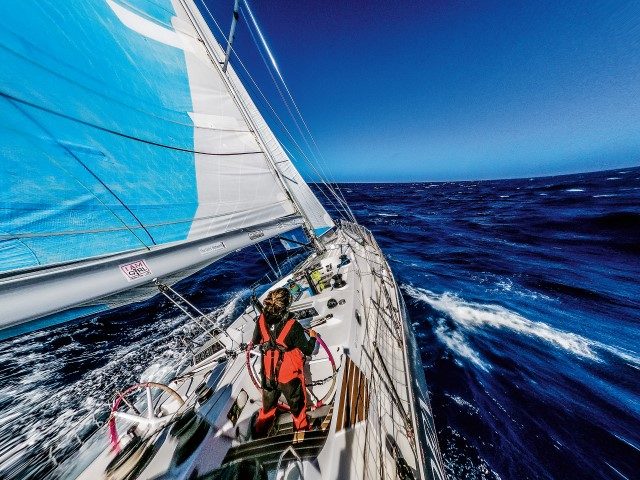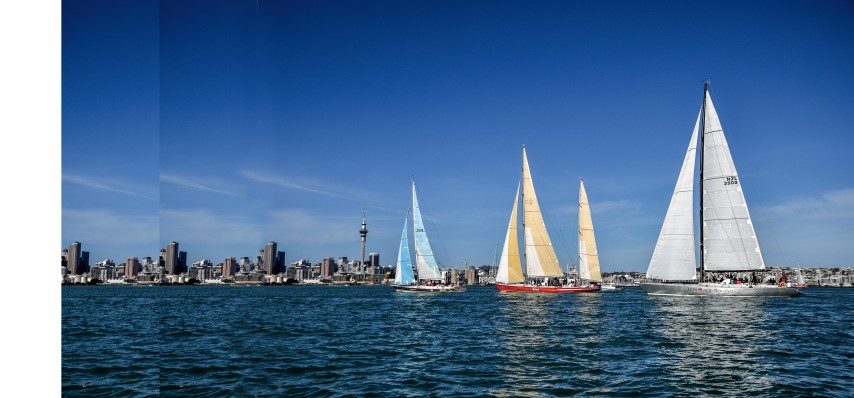

An iconic race-yacht with an all-women crew left Auckland in June on an inspirational voyage to empower women, promote education for girls – and advance a little tolerance and understanding in a messed-up world. Kia Korupp caught up with the crew.
I recently invited some friends for dinner, and after the meal we pulled out some conversational cards to discuss, one titled: “Who would be your ultimate dinner party guest?” Names of the rich and famous rolled off our tongues – Mick Jagger, Meryl Streep, Graham Henry, Stephen King, Obama, David Attenborough and, for the shallow-minded, Pamela Anderson. The list of activists, pop stars and celebrities was long, the likelihood of their company at my table completely unrealistic.
A month later I found myself standing on the pier in the Viaduct with the all-woman crew of Maiden, talking to sailing icon Tracy Edwards about her past triumphs and her present campaigns, and realised that I was standing with my ultimate dinner guest. Her story was inspiring, what she had accomplished bold, and here she was in the middle of making it happen all over again.

To understand the significance of Edwards’ current mission, you have to understand the significance of her past success. Rewind to December 1989 when Maiden – a 58-foot high-performance racing yacht – sailed into Auckland Harbour to claim the first of two winnings in an around-the-world race no one thought she was capable of competing in.
Why was the yacht deemed so unfit? Because it was full of women. For the first time in racing history, an all-female team had entered an elite, high-performance event and few believed they were capable of getting to the start line. While a few women were able to get on-board race boats as support to a male-dominant crew, at the time women were not considered equal to men in the sport.
Edwards, owner and skipper of Maiden at the time, recalls: “No one thought the girls would finish a leg, let alone finish the race. When we came in third on the first leg we were gutted – everyone else was happy we were alive. It was a real juxtaposition between how we saw ourselves as a serious, competitive crew in a race – taking risks, pushing the boat – and how everyone else saw us. Our picture of ourselves was so different.”
Was she aware at the time of her influence in promoting women in sailing? “No, because quite honestly we weren’t doing it for that. I selfishly was doing it because I wanted to be a navigator on an around-the-world race boat. The only way I was going to make that happen was if I made it happen. When the whole misogyny thing kicked-in I realised I was in the middle of a battle I didn’t know existed. And then the gloves came off.”
While women’s equality in the sport was not the original intention of competing in the 89/90 Whitbread Round the World Race, their success proved that women were as capable of competing professionally as their male counterparts. Edwards and her crew finished second in their class, winning two out of six individual legs in the race, the best finish by a British boat in 17 years – an achievement unbeaten to this day.

I’d like to say the rest is history, but here we are in the middle of watching Edwards make her mark in gender equality all over again. Almost 30 years later, that same boat was driven into Auckland Harbour by an all-female team in a circumnavigation set to make another mark in history.
This time the boat and crew sail in under the banner of The Maiden Factor, a fundraising effort focused on raising awareness for girls’ education. “I am passionate about girls’ education,” says Edwards. “It is the key to equality. And if we don’t have equality this world has had it – it forms part of every problem we have.”
Maiden’s new mission is sailing 60,000nm to reach 30 destinations in a two-year circumnavigation to raise funds for the foundation. In addition, its objective is to raise awareness: “This is probably more key than raising funds,” says Edwards. “I feel very proud of what we did in an ongoing battle – and it’s time to see if Maiden is up to the task again.”
The boat’s well-primed to do just that. She holds a rotating spot for a skipper, four permanent crew positions and four temporary guest spots. Having departed New Zealand in early June, Maiden is currently skippered by Wendy Tuck, winner of the 2017-18 Clipper Race and the Jane Tate Memorial Trophy, claiming her place in history as the first female skipper to win an around-the-world yacht race.
Tuck is supported by co-skipper Sharon Ferris-Choat, two-time Olympian, who has also raced around the world – three times – completing over 90,000 offshore miles. The pair, who joined the team in Australia, will helm Maiden through the next stage of her transit, a 3,820-mile passage from New Zealand to Hawaii.
Reflecting on the impact that Maiden’s first triumph had on her life, Ferris-Choat says “Tracy has opened so many doors for hundreds of people to be innovative and climb those dream mountains. If I can inspire others as Tracy has done, I will be truly happy.”
When Maiden pulled out of Auckland 30 years ago, there was one New Zealander on-board. This year, five out of the nine crew are Kiwis. Sharon Ferris Choat, a Northlander, is joined by the four new recruits: Jo Ivory, 55, member of the New Zealand Sailing Trust and first mate of Steinlager 2; Rebecca Gmuer Hornell,19, a Royal New Zealand Yacht Squadron’s Youth Training Programme graduate; Natasha Fickling, a 38-year old mother of two with cruising aspirations and Natalie Bratkowski, 36, accruing sea miles to complete a Yachtmaster’s certification.

The four positions are reserved for ‘mile-builders,’ sailors who want to develop their skills and who need more open ocean experience to attain sailing qualifications. All four women knew the inspiring history of Maiden’s past and wanted to be a part of her inspiring future.
The four permanent crew include: Matilda Ajanko, a Finnish sailor with over 50,000 miles of experience; Belinda Henry, an Australian with 15 years in the marine industry who has accrued over 90,000 sailing miles; Courtney Koos, an American and winner of Panerai’s Under 30 Classic 2017 Sailor of the Year; and Amalia Infante, a Spaniard and author of Life Behind the Sails, brought onboard as the offshore media producer.
“We all come from a pretty diverse sailing background,” says Henry, “and everyone left something to be here. But everyone saw the project for what it was and really appreciated the concept and made an effort to be here because it is so special and such a rare thing.”
Adds Koos: “In sailing, people spend so much money on boats. Racing is a lot of fun and it is amazing to have those opportunities as a woman in such a male-dominated industry, but you get to a point when you ask, ‘Am I making this world a better place?’ It starts to feel frivolous at times, and it now feels like we have landed on a better path, to be able to influence another generation of sailors.”
LEAVING AUCKLAND
On 9th June, Maiden sailed out of Auckland on an estimated 23-day passage that will return her to the northern hemisphere with five of our own on-board. As with Maiden’s first journey around the globe, the path that lies ahead is being formed as she goes – as well as her purpose. The same is true for The Maiden Foundation, which will continue to be sculpted by those who influence the project along the way.
Of the future of Maiden and the foundation, Edwards discusses the organic nature of the project. “There is a threeyear beginning and end. The boat is one part of it, but the future is in the charity. That is what we are really keen to develop. When the boat stops, which she will have to do at some point, the charity will continue.
“The thing I have learned in this process is not to make too many premature decisions that you then have to stick by. Along the way we have to ask, ‘What does this look like now? What does it feel like?’ And we have to be guided by who we are talking to. It is no good for me to tell children what to think. It is all about what they are telling us – and we have to listen.”

My dinner party guest list is now full. Tracy Edwards gets to sit at the head of the table – she has earned that right.
Filling up the rest of the guest list is Maiden’s crew, the women who are driving the historic yacht towards her next success. I want their stories – the cyclones and the doldrums, the equatorial passage rituals, the pirate attacks, the burning engine and the ripped sails.
I want to hear about the moments that touched their lives as they reached out to touch other lives. I want to be surrounded by these women who, in the very few hours that I got to talk with them, lit a fire in my gut. They inspire. They enlighten. They accomplish. They make history. Sorry, Pamela, there’s no room at the table for you anymore!
THE MAIDEN FACTOR FOUNDATION
The foundation grew organically out of an unexpected phone call in 2014 from a marina manager in the Seychelles, informing Edwards that Maiden was about to be dragged out of the marina and scuttled. Having been through five owners after Edwards’ ownership, the boat was eventually left abandoned in the Seychelles.
At the time of the phone call Edwards was at a crossroads and was looking for a new project to take on. “At that stage I had no plan for her,” she recalls. “Maiden is part of maritime history and I thought perhaps I could do her up and give her to the maritime museum. Then I thought, ‘No, she still has energy and life in her yet.’”
Inspiring girls to sail has always been Edwards’ focus, but with so many other great sailors out there doing just that, she felt there must be another avenue. “Then my daughter Mack said to me, ‘Why don’t you use the boat to raise money for girls’ educational charities and raise awareness?’” And The Maiden Factor was born.
In April 2017 Edwards was able to raise the funds to get Maiden returned to the Hamble – the same place where the boat was restored for the 89-90 Whitbread race. “We rescued her the first time and I realised we would be doing it again 30 years later,” stated Edwards. “It is incredible to have two lives with a boat like that.”
The Maiden Factor Foundation has teamed up with six charities to raise funds and run a campaign to empower a girl and change the world. Was there a theme in selecting the specific charities? “Yes. They all tackle what stops girls from getting an education,” says Edwards. “In my ignorance I thought it was all about poverty. What I began to learn was that it isn’t just poverty that stops girls going to school.”
The six charities all seek to tackle the same problem with a different approach. The Orchid Project highlights the issues of genital mutilation. Just a Drop helps dig wells and assists women in the community to manage the wells. Positive Negatives addresses education through the distribution of literature and online media. The Girls’ Network focuses on keeping girls in school rather than getting them into school. Fields of Life engages with all family members to teach them that girls are more valuable with an education than trading them off. Room to Read focuses on teaching boys how important it is for girls to have an education.
“That is so key,” says Edwards, “otherwise you are just having a conversation with one part of the problem.” Has their involvement in Maiden’s mission changed their perspective on their involvement in charity work? “One hundred percent,” says Koos. “What got me involved in it was sailing, obviously, and taking a boat around the world is another tick off my list. But then it had the added bonus of being a charity. That’s when I realised it was opening a whole new world of ideas and things that I would like to continue to do. After this is finished, it would be nice to get on the ground and work alongside charity work.”
GENDER EQUALITY
Maiden’s story – both past and present – is about gender equality.
Standing in the galley sharing a platter of muffins, Koos and Henry mention an event involving pirates, a barracuda and a beheading – my ears prick up, curious to hear how three totally incongruent things could be woven together and planted under the banner of gender equality. Koos sets the scene.
“All this stuff gets delivered to the boat in Eritrea where they had the floating arsenal and we did the weapon pick-up. At sunset a tender pulls up under the cover of darkness with two men on-board who start throwing massive pelican cases and boxes of guns, bullets and magazines at us while running the boat alongside at nine knots.”

After loading up, the four armed guards (brought on-board for protection through the high-risk area off the Horn of Africa) run the crew through emergency scenarios trying to mentally prepare everyone in the event of an attack. “There was code green, code amber, and code red. We had this bullet-proof body armour and night-vision goggles. They had semi-automatic weapons and we had to run through these drills. All pretty exciting.They kept telling us to take it seriously, they didn’t think we could handle it.
“And then, between Yemen and Somalia we catch a barracuda. Nikki and Bell are reeling it in and I was driving. We get the fish on deck and the guys are standing around looking at it. Bell is holding the fish down and Nikki, without blinking an eye, gets a cleaver and cuts its head off. And in that moment, all the security guards made eye contact and looked totally disturbed by what they’d seen. I think they didn’t think we had it in us to kill this fish. That’s when it all clicked that we could handle it mentally.”
As men who have never worked with women before, the barracuda story represents a moment where the two parties looked at each other as equals. “There was a balance,” continues Henry. “We put ourselves in their hands with regard to security, and they put themselves in our hands in regard to safety. A mix of sailors and non-sailors, both were relying on each other for their individual welfare.”




